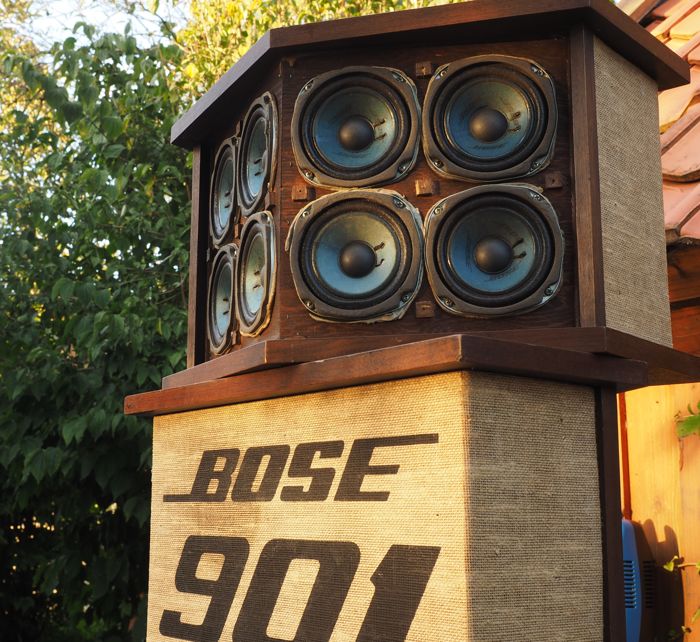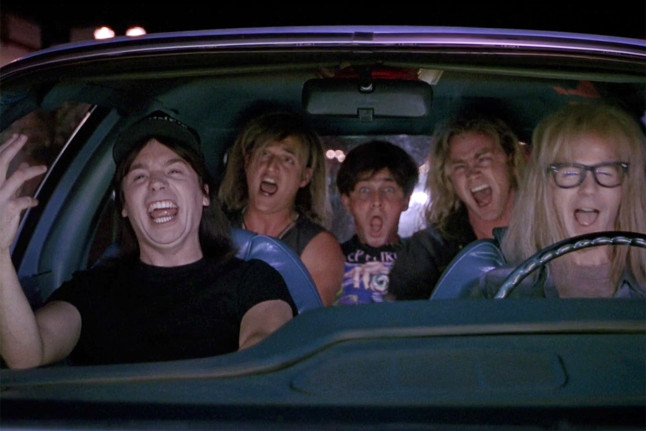Not long after our previous episode, my pants from All American Clothing arrived. The “seconds Canvas Utility Pants” ($24.95) had a minor sewing flaw on the button hole: I’ve purchased clothes off the rack with far more glaring faults. The Khaki AA Casual Pants ($54.95) which I am wearing now are comfortable and well-made. Both are as good or better than any imported clothing I have purchased at comparable price points and far nicer than the stuff you’ll find on most retail racks. I look forward to more purchases with All American Clothing and other American clothing manufacturers and will keep you up to date on any new outlets I find.
I also had the chance to indulge one of my other hobbies — vintage stereo. A gentleman on Craigslist had a pair of Bose 901 Series II speakers available for a very reasonable price. As J. Gordon Holt described the Bose 901s in a 1971 Stereophile review:
Perhaps the most important single factor in the 901’s sales is its awesomely spacious sound, which makes other systems in a showroom sound a bit trivial, as if the Bose is the Truth and the Light, and the others are just playing around. The 901 sounds fantastically open and spacious, with a big, fat low end and a socko you-are-there presence that seems to put the performers right in the room, surrounded by the original auditorium.
Amar Bose, an Electrical Engineering professor at MIT, noticed that many speakers which reproduce a signal “accurately” fail to capture the sounds of a solo guitar or a symphony orchestra. Inspired by the acoustics of concert halls, Bose put placed eight small full-range speakers behind a single speaker. The listener heard both the immediate signal and the pleasant reverberation heard in a cathedral or concert hall. To capture the full range of music Bose created an equalizer which boosted the high and low frequencies. The final product, the Bose 901, was released in 1968 and remained in production until 2017. (Alas, while my c. 1974 901s were built in Framingham, Massachusetts today most Bose products are manufactured in their offshore plants or by foreign contractors).

The equalizer boost (as much as 18dB on the low end) places heavy demands on an amplifier. A 3dB increase in signal requires twice the power: that means a fat bass beat which a big speaker might reproduce with a 1 watt signal will need 64 watts on the 901s. My new 901s are hooked up to a 200-watt Crown XLi800 . Crown was founded in 1947 by Clarence C. Moore, an Indiana minister and engineer. Crown amplifiers have long been legendary in professional audio: their DC 300 revolutionized sound design. Crown’s factory in Elkhart closed in 2017 and today most Crown gear (including my XLi800) is made in China.
The original equalizer needs to be serviced. In the interim I am using a DSP (digital signal processor) which Deer Creek Audio has programmed with the original curve. While Deer Creek is an American company — and highly regarded by Bose lovers — the DSP they used was made in China. I can’t fault them for that, as to the best of my knowledge no DSPs are being produced in the United States.
My equalizer is plugged into a Topping D30 DAC (Digital-Audio Converter) which is connected to a MacBook Pro via USB. The Topping is Chinese, and while it does the job serviceably I am hoping to upgrade soon to a DAC by American manufacturer Schiit Audio. (Yes, I know…). And by the time my MacBook Pro was built in late 2011, Apple had largely washed its hands of American manufacturing. But these were in the end, minor quibbles. As every audiophile knows, in the end it all comes down to the music.
So how did they sound? A picture paints 1,000 words.

The Bose 901s sound as American as Technicolor, 21-gun salutes and Busby Berkeley musicals. They are big, beefy, overblown, unrepentant, loud and glorious. Don’t get me wrong, they can do quiet passages beautifully. But nobody goes to a Broadway show to hear Ethel Merman sing a lullaby. The 901s shine with excess. Your life is not complete until you’ve experienced Ronnie James Dio reverberating around your room like the Ghost of Hair Metal Past. Play 70s classics and your appliances will turn avocado green: disco sounds fabulous even without cocaine. And if you want to feel that orchestral swell when ppp becomes fff, the 901s will give you all the volume you could ever want without distortion.
Many of America’s legendary stereo lines exist only as logos now if they exist at all. Samsung owns Crown alongside dbx, JBL, Harman Kardon, Infinity and Mark Levinson. KLH once produced popular clock radios and consoles: today the label is used to market cheap Chinese garbage. But there are still a few American audio firms manufacturing in-country. Magnepan still manufactures their speakers in Minnesota. (As they proudly say “Made in America. Sold in China.”) McIntosh continues to construct its product at its Binghamton, New York headquarters. And there are any number of American boutique operations offering tube amplifiers, solid state amps, headphones or other audio gear. If you want to start buying American, the audio equipment market offers a few surprising bright spots amidst the expected desert of Asian imports.

Leave a comment